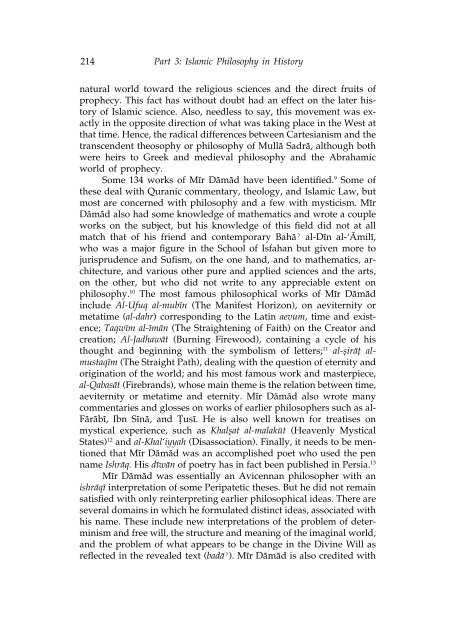Islamic Philosophy from Its Origin to the Present: Philosophy in the ...
Islamic Philosophy from Its Origin to the Present: Philosophy in the ...
Islamic Philosophy from Its Origin to the Present: Philosophy in the ...
Create successful ePaper yourself
Turn your PDF publications into a flip-book with our unique Google optimized e-Paper software.
214 Part 3: <strong>Islamic</strong> <strong>Philosophy</strong> <strong>in</strong> His<strong>to</strong>ry<br />
natural world <strong>to</strong>ward <strong>the</strong> religious sciences and <strong>the</strong> direct fruits of<br />
prophecy. This fact has without doubt had an effect on <strong>the</strong> later his<strong>to</strong>ry<br />
of <strong>Islamic</strong> science. Also, needless <strong>to</strong> say, this movement was exactly<br />
<strong>in</strong> <strong>the</strong> opposite direction of what was tak<strong>in</strong>g place <strong>in</strong> <strong>the</strong> West at<br />
that time. Hence, <strong>the</strong> radical differences between Cartesianism and <strong>the</strong><br />
transcendent <strong>the</strong>osophy or philosophy of Mullå Sadrå, although both<br />
were heirs <strong>to</strong> Greek and medieval philosophy and <strong>the</strong> Abrahamic<br />
world of prophecy.<br />
Some 134 works of M¥r Dåmåd have been identified. 9 Some of<br />
<strong>the</strong>se deal with Quranic commentary, <strong>the</strong>ology, and <strong>Islamic</strong> Law, but<br />
most are concerned with philosophy and a few with mysticism. M¥r<br />
Dåmåd also had some knowledge of ma<strong>the</strong>matics and wrote a couple<br />
works on <strong>the</strong> subject, but his knowledge of this field did not at all<br />
match that of his friend and contemporary Bahå˘ al-D¥n al-‘≈mil¥,<br />
who was a major figure <strong>in</strong> <strong>the</strong> School of Isfahan but given more <strong>to</strong><br />
jurisprudence and Sufism, on <strong>the</strong> one hand, and <strong>to</strong> ma<strong>the</strong>matics, architecture,<br />
and various o<strong>the</strong>r pure and applied sciences and <strong>the</strong> arts,<br />
on <strong>the</strong> o<strong>the</strong>r, but who did not write <strong>to</strong> any appreciable extent on<br />
philosophy. 10 The most famous philosophical works of M¥r Dåmåd<br />
<strong>in</strong>clude Al-Ufuq al-mub¥n (The Manifest Horizon), on aeviternity or<br />
metatime (al-dahr) correspond<strong>in</strong>g <strong>to</strong> <strong>the</strong> Lat<strong>in</strong> aevum, time and existence;<br />
Taqw¥m al-¥mån (The Straighten<strong>in</strong>g of Faith) on <strong>the</strong> Crea<strong>to</strong>r and<br />
creation; Al-Jadhawåt (Burn<strong>in</strong>g Firewood), conta<strong>in</strong><strong>in</strong>g a cycle of his<br />
thought and beg<strong>in</strong>n<strong>in</strong>g with <strong>the</strong> symbolism of letters; 11 al-ƒirå† almustaq¥m<br />
(The Straight Path), deal<strong>in</strong>g with <strong>the</strong> question of eternity and<br />
orig<strong>in</strong>ation of <strong>the</strong> world; and his most famous work and masterpiece,<br />
al-Qabasåt (Firebrands), whose ma<strong>in</strong> <strong>the</strong>me is <strong>the</strong> relation between time,<br />
aeviternity or metatime and eternity. M¥r Dåmåd also wrote many<br />
commentaries and glosses on works of earlier philosophers such as al-<br />
Fåråb¥, Ibn S¥nå, and appleus¥. He is also well known for treatises on<br />
mystical experience, such as Khalƒat al-malak¶t (Heavenly Mystical<br />
States) 12 and al-Khal‘iyyah (Disassociation). F<strong>in</strong>ally, it needs <strong>to</strong> be mentioned<br />
that M¥r Dåmåd was an accomplished poet who used <strong>the</strong> pen<br />
name Ishråq. His d¥wån of poetry has <strong>in</strong> fact been published <strong>in</strong> Persia. 13<br />
M¥r Dåmåd was essentially an Avicennan philosopher with an<br />
ishråq¥ <strong>in</strong>terpretation of some Peripatetic <strong>the</strong>ses. But he did not rema<strong>in</strong><br />
satisfied with only re<strong>in</strong>terpret<strong>in</strong>g earlier philosophical ideas. There are<br />
several doma<strong>in</strong>s <strong>in</strong> which he formulated dist<strong>in</strong>ct ideas, associated with<br />
his name. These <strong>in</strong>clude new <strong>in</strong>terpretations of <strong>the</strong> problem of determ<strong>in</strong>ism<br />
and free will, <strong>the</strong> structure and mean<strong>in</strong>g of <strong>the</strong> imag<strong>in</strong>al world,<br />
and <strong>the</strong> problem of what appears <strong>to</strong> be change <strong>in</strong> <strong>the</strong> Div<strong>in</strong>e Will as<br />
reflected <strong>in</strong> <strong>the</strong> revealed text (badå˘). M¥r Dåmåd is also credited with

















